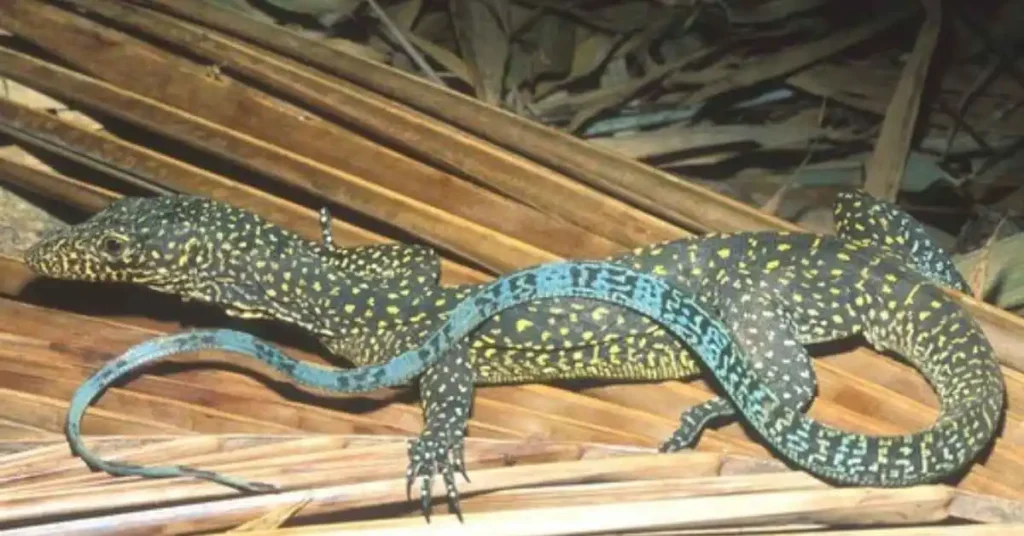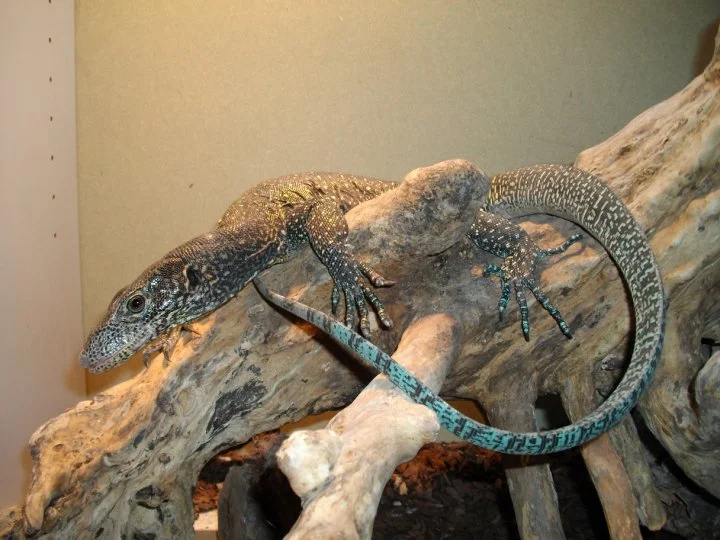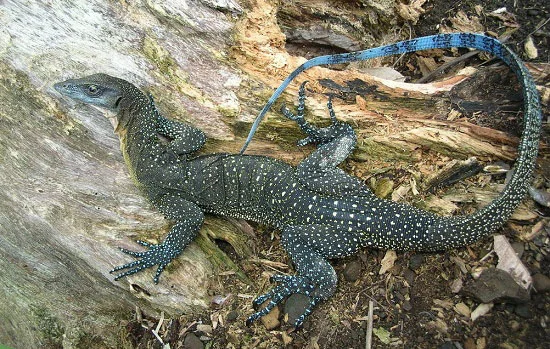Blue Tail Monitor
The Blue-tail monitor is an awesome reptile found in the forests of eastern Indonesia. Its bright blue tail gives it its name. Due to its brilliant colors and unique physical features, this animal is popular among reptile enthusiasts and biologists.
Origin of the Blue Tail Monitor:
The Blue-tailed monitor originates from New Guinea and nearby islands. It is found in warm forested areas, usually near rivers and streams. Its natural habitat includes high temperature, humidity, and dense vegetation, which provides the perfect environment for its climbing and hiding.
Overview About Blue Tail Monitor:
- Common Name: Blue Tailed Monitor
- Scientific Name: Varanus doreanus
- Size:2-3 feet in length
- Age: 12–20 years

Physical Appearance of Blue Tail Monitor:
The blue-tailed monitor is a medium to large reptile, typically 2 to 3 feet long. Its most prominent feature is its bright blue tail, which stands out against its usually dark or spotted body. Its skin is covered with smooth scales that can vary in color, often brown, black, or olive with light spots or stripes. The body of the monitor is long, thin, and strong, which gives it the ability to climb. Its head is long, and its sharp eyes are well-adapted for hunting. Males are usually larger and may have more pronounced coloration than females.
Temperament and Behaviour of Blue Tail Monitor:
The blue-tailed monitor has a unique temperament characterized by fascination and flexibility. Unlike many reptiles, they are unusually sociable and can engage in playful interactions when kept in pairs. They exhibit emotional sensitivity, responding positively to calm handling and often forming bonds with their owners. Their inquisitive nature leads them to explore their environment thoroughly, displaying intelligent behaviors like “exploratory walks” to investigate new objects and changes around them. Overall, they make fascinating companions for reptile fans.
Food and Diet of Blue Tail Monitor:
The blue-tail monitor primarily has a carnivorous diet. It feeds on:
- Insects: Such as crickets and beetles.
- Small mammals: Like rodents.
- Birds: Including their eggs.
- Other reptiles: Such as smaller lizards.
In captivity, it is very important for blue-tailed monitors to be fed a protein-rich diet. This should include worms, small rodents, and suitable commercial lizard food. This diet is very fundamental for their health and Welfare. Without correct nutrition, these animals can be hurt by various health problems, so it is important to take special care of their diet for their proper care.
Blue Tail Monitor Care:
Caring for a blue-tailed monitor is not an easy task. They require special attention and a high level of knowledge about reptile care.
You will need a very large cage, one that provides adequate heat, light, and humidity levels, a special diet, and a constant source of water.
Whatever type of enclosure you use, it must be maintained very cleanly, and the floor layer should never be too wet. Finally, you have to know your pet’s temperament well. These animals are not exactly warm and loving. In some cases, these can prove to be dangerous, so caution is necessary.
Housing of Blue Tail Monitor:
Blue-tailed monitors live in forests where the temperature is warm and the air is humid, especially near rivers. This creature loves to live in wet forests where there are plants and trees. Mangrove monitors live near water and swim to catch fish.
Use heaters to keep their cage warm, and fill it with live plants. Add a large bowl of water to allow the monitor to float.
Enclosure Size:
A suitable adult cage size for a blue-tailed monitor should generally be at least:
- Length: 6 feet (1.8 meters)
- Width: 3 feet (0.9 meters)
- Height: 4 feet (1.2 meters)
A larger cage is always better, as these monitors are active and need space to walk, climb, and explore. It is also useful to provide vertical climbing branches and hiding places to make the environment more interesting.
Humidity:
Relative humidity levels in the blue-tailed monitor’s habitat are optimal at around 60-80 percent. Their health depends on the level of humidity in the air around them. Often, they splash water on themselves to add moisture to the air for their skin and respiratory system.
Many people prefer mulching materials that have water-holding properties, such as coir and cypress, which make the environment comfortable and natural. Along with the application of water-absorbing mulch and sprinkling, this will help maintain adequate moisture levels for the blue-tailed monitor.
Substrate:
Cumin is the material used in the blue-tailed monitor’s cage. It helps retain moisture and satisfies the monitor’s desire to dig. In addition, it provides a more natural look and feel to the creature.
So, try to use one that reflects the natural environment of the monitor. Many homeowners use chemical-free soil, leaves, and moss. Lay it at least 4 inches deep so your monitor can dig in easily.
Lighting:
Adequate lighting is vital for blue-tailed monitors because it changes their calcium intake and health. They require about 12 hours of UVB light per day to prevent bone disease. Using customized UVB lamps helps Copy Natural sunlight in an indoor environment. Turning off the lights at night is necessary to keep the natural day-night cycle. Meeting these lighting requirements is critical to ensuring a long and healthy life for blue tail monitors.
Heating:
Daytime temperatures for blue-tailed monitors need to be around 85 to 95 degrees Fahrenheit, while habitats for nestlings can reach 100 degrees. At night, temperatures can drop to around 70 to 80 degrees Fahrenheit. To maintain these temperatures, use base lamps or ceramic heat emitters, and make sure the cage has different temperature zones so the monitor can regulate its body temperature well. Adequate heat is essential for their metabolism and overall health.

Why are Blue Tail Monitors special as pets?
Blue tail monitors are attractive pets due to their playful and wandering Nature, which makes them fun to observe. Their cleverness allows them to learn quickly, deepening the bond with their owners. They can live for many years, fostering long-lasting friendships. Adaptable to various spaces, they fit well into different lifestyles and teach valuable lessons about responsibility. With their stunning colors and unique features, they bring beauty and joy to any home.
Breeding Of Blue Tail Monitor:
Breeding blue tail monitors can be challenging, and it’s crucial to meet all their natural needs, as they can easily suffer if conditions in captivity do not mimic their natural habitat. The breeding season typically occurs during the warmer months when temperatures rise. Males often engage in courtship behaviors, including displaying and head bobbing. Females will lay their eggs in a secure nesting site, usually in a burrow or substrate that allows for digging. After laying, the eggs need a warm, humid surrounding for incubation, which usually lasts between 60 to 90 days. Supplying suitable temperature and humidity during this period is important for successful hatching and the health of the hatchlings.
Lifespan of Blue Tail Monitor:
With good care, blue-tailed monitors can live for about 15 to 20 years. But, not much is recognized about their life span in the wild. To secure their health and longevity, it is very essential to give them a balanced place, a balanced diet, regular vet check-ups, and an interesting environment.
Common Health Problems of Blue Tail Monitor:
Parasites, such as mites and ticks, can infect blue-tailed monitors. These insects can cause skin inflammation, itching, and discomfort for the lizard. It is very important to check your monitor regularly to detect any signs of parasitosis.
The blue-tailed monitor’s tail is an essential part of its body, used for balance and communication. However, the tail is also sensitive to injuries, such as bites from other creatures’ teeth or accidental injuries. If the tail is injured, it is important to get veterinary help immediately to prevent infection and further damage.
Handling and Care Tips for Blue Tail Monitor:
When picking it up, support it securely with both hands as you approach your blue tail monitor and do your best to keep from startling them. First, try short handling sessions, and increase the time watching for signs of stress. Supervised exploration can also help to build confidence.
A big, well-ventilated enclosure with lots of climbing potential and hiding places is required. Feed insects and small rodents a protein-rich diet, and offer fresh water at all times. Daily clean waste and clean deeper periodically. Helps with bone health and changes bulbs periodically with UVB lights. Finally, if you don’t see any signs of illness, check regularly.
If you follow these tips combined, you’ll ensure your blue tail monitor stays healthy and happy!
Price and Cost of Blue Tail Monitor:
Here’s a rough estimate for blue tail monitors:
- Captive-bred Blue Tail Monitor: $300-$600
- Male Blue Tail Monitor: $400-$800 (varies by size and lineage)
- Female Blue Tail Monitor: $500-$1,000 (often higher due to breeding potential)
Conclusion:
The Blue-tail monitor is an awesome reptile. Its bright blue tail gives it its name. Due to its brilliant colors and unique physical features, this animal is popular among reptile enthusiasts and biologists. Blue-tailed monitors live in forests where the temperature is warm and the air is humid, especially near rivers. This creature loves to live in wet forests where there are plants and trees. Mangrove monitors live near water and swim to catch fish.







